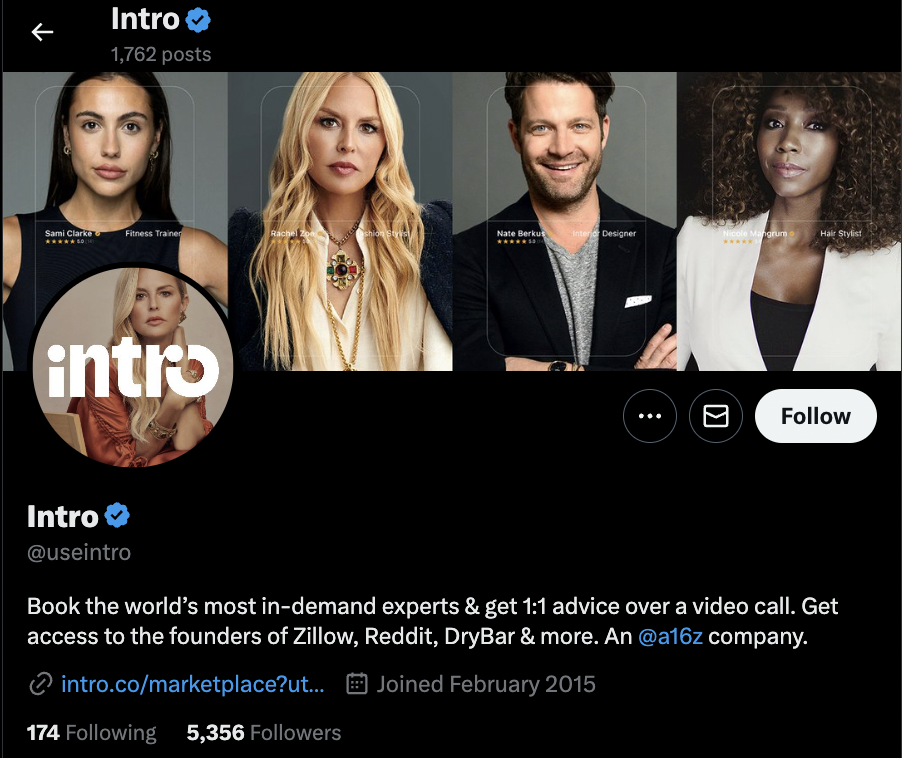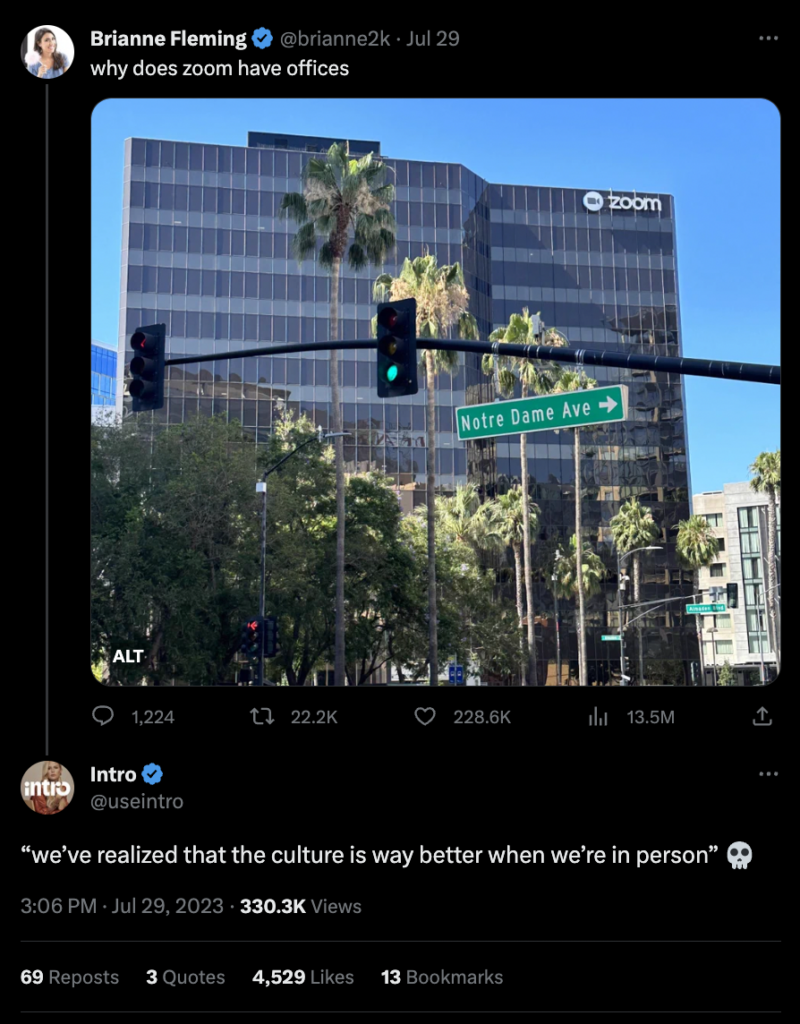21 August 2023 | Marketing
How Intro is taking over the X timeline 📈
By
3 simple strategies your B2B business can steal, this week

I spend way too much time on X (I used Twitter in the subject line just in case … I’m still conflicted).
Over the past 3-4 weeks I’ve noticed a company popping up on my timeline more and more.
At first, I didn’t really pay any attention.
Then I thought ‘Hmm, that’s interesting.’
And finally it got to the point where I had to take a deep dive into their playbook. What sold me here is that their content kept getting served to me passively.
In other words, I wasn’t doing research for a case study like this one. The algorithm just kept serving me more and more touch points with them.
First, some brief context. What is Intro?
According to their X bio, it’s a platform that allows you to “book the world’s most in-demand experts & get 1:1 advice over a video call.”
Like Cameo, but for business advice. Kind of.
Not gonna do a super deep dive into the product itself, as this isn’t a sponsored piece. Though, it can be (hit me up 🤝).
Today I want to walk you through 3 principles they’ve used to go from 0 to 100 on X within the span of a few months. Shall we?
I. The Reply-Guy Playbook 💬
Most companies on X—or most social platforms, really— make a critical error when starting a brand presence from the ground up.
They post way too much original content, and not nearly enough replies on other niche-related content.
Replies are underrated.
Why? Two reasons.
One, you can brute force your way onto your target customers timelines by finding out who they engage with and leaving either thoughtful or funny replies underneath their content.
Two, it’s a way to start building real community with your potential customers.
Intro has been running this strategy at an A+ level.
Whoever is running their account is almost treating it like a personal account, taking the time to engage with customer feedback and on other related content.
Here’s an example:

A note here. I’m a fan of the use of first person on brand accounts (using “I” over “we”). It feels more personal, and doesn’t feel as corporate.
Internal teams may have differing opinions, but it’s worth considering.
They also do a great job of jumping in on viral tweets early, to siphon some of the viewership.
Another example:

This tweet probably took ~2-3 minutes to write up, and it netted 330.3K views.
That said, not every reply has to be super thoughtful, or trying to hack viewership from a viral moment.
Sometimes a simple emoji or two works well, like this:

Just seeing your brand on the timeline is another touchpoint with the customer. It may not feel like much, but this (and all of your other social content) add up over time to increase mindshare in the consumer.
I see them pop up on my timeline several times per day. And again, this was before diving deeper into the strategy for this case study.
Remember, there’s a fine balance between reply quantity and reply quality. Over time as a social media marketer, you come to understand this.
Now, the question is:
Why don’t more companies do this?
Truth is, it’s hard. And it’s not ‘scalable.’
Executing a reply-oriented strategy takes a dedicated social media professional who understands:
- Platform nuances
- Key influencers in your niche
- Key language and inside jokes in your niche
- Has ‘trigger discipline’ and can decide when not to hop into a conversation
It also just takes time. You can’t automate replying to your community with AI — though, some people have been trying to on LinkedIn… lol.
Playing the reply game is a non-negotiable for a new account starting out on Twitter, and it has compounding effects when done right.
Replying actively makes it feel like you’re everywhere.
Now, let’s talk about another method Intro uses to make it feel like they’re everywhere.
II. Influencer Amplification 📣
B2B influencer marketing (done right) is one of the best ways to supercharge your social media presence early on. It can help you leap frog a lot of the growing pains I mentioned earlier (posting into the void).
There are 3 types of B2B Influencers:
- True influencers — you pay them a retainer, pay-per-post, whatever.
- Investors — these people have equity in your company, and are incentivized to help you grow.
- Collaborators — sometimes influencers are actually part of the product, giving it built-in distribution (spoiler: Intro has this)
Sometimes, you see a combination of 2-3 of these.
You also have your employees that you can lean on to amplify your posts, but that’s more ‘employee advocacy’ than influencer marketing, so I’ll save that for a different essay.
Influencer marketing isn’t a revolutionary strategy. I’m not trying to paint it as such. But it is still a relatively ‘newer’ lever to pull in B2B. Consumer brands have been doing this for ages.
I see B2B Influencer Marketing work well across the board for startups, but I think it’s hyper-relevant for Intro.
The experts are the product. So why not leverage them in the content strategy as much as possible?
The cloudy part about this —and what makes this piece a bit challenging for other brands to replicate 1:1—is figuring out the deal structure for each influencer.
Are they paid a retainer to amplify content + engage content? Are they investors? What deliverables are expected of them (posting original Intro content, reposting, etc)?
I’ve seen a few different playbooks used here, but generally you need to incentivize these big players to post somehow.
Anyway, what does the execution of this look like once you have influencers on roster?
Again, 2 types of influencers activations:
1) Original content
The influencer posts content related to the brand their their account.
Here’s an example from an Intro investor, Alexis Ohanian, that pulled 172.3K impressions:
Another example of this, coming from Paul Goodman, an exited founder (sold his business, Pura Vida, for $120M) who consults on Intro:
This type of content usually gets better engagement than a piece of brand content, especially for an early stage company.
- Amplification of brand content
Even though the ‘people engage with people’ is true, and personal brands usually see better on-platform engagement than brand accounts for early-stage companies, this doesn’t mean you should neglect branded content.
When you have access to influencers and investors with audiences, you’re in the perfect position to leap frog a few steps as a brand account.
If you’re in X, you can have influencers repost your content, comment underneath it, etc. All of these tactics get the content in front of more people. It’s not rocket science.
Same goes for other platforms: LinkedIn, Instagram, TikTok, etc. How can you tap into your company’s network to amplify brand content?
Both of these types of activations are useful. Lean into them.
III. Pick your spots 🎯
Intro still posts content on their brand pages. This is smart.
Like I said earlier, personal brands tend to get higher engagement — this makes it tempting to ditch the company page altogether. Don’t do this.
Caveat: in the early days, especially if you don’t have the influencer network to lean on and/or a team capable of supporting both brand and personal accounts, you may be forced to pick.
But ideally, you have both brand and personal/influencer content hitting the timeline all at once.
One misconception marketers for newer companies have is they think they have to post 3-4x per day on social to get anywhere.
They’re playing the quantity game.
I don’t hate this (like we established, more touchpoints is generally good), but here’s the thing:
More bad content, is still bad content.
And arbitrary cadences (i.e. “we need to post 3-4x per day!) set you up to ship bad content just to hit your output numbers.
I like how Intro is selective with their native brand content on X. Here are two of their few recent brand posts…
This thread got 161K views:
This thread got 23.7K views:
There is nuance when discussing the quantity VS quality debate. And the correct answer depends on your company.
I like to think of it on a spectrum.
When you have more distribution through investors and influencers, you have more leeway to be ‘selective’ with your content (I’d imagine these pieces gained traction because Alexis or another influencer shared them).
To use an extreme example, say LeBron launched a new company. All he has to to is repost a piece of content from the company with a basic CTA to go follow, and the company would gain thousands (if not hundreds of thousands) of followers overnight.
When it’s just you and your company page fighting or your life out there on the timeline — you’re gonna need to throw a bunch of darts and see what lands. This is one of the reasons why early social growth can feel flat. You just don’t know what works, and you don’t have a bought-in community yet.
On the flip side…
There’s the phenomenon of posts you half-ass and throw up last minute absolutely popping off (have seen this phenomenon multiple times), so dismissing content because the ‘quality’ isn’t good can be dangerous.
But… you also don’t want to ship crappy work. See how much back and forth you can get yourself into over this?
TLDR — nuance, lot’s of nuance.
And I think Intro is taking the right approach leaning heavily into replies, influencer generated content, and the occasional brand account banger.
Final Thoughts 🧠
A proper social strategy is a well-oiled machine:
- Branded content
- Branded replies
- Influencer content
- Influencer amplification
- Collaborator content (i.e. the founders who are on Intro)
- Employee content
All of this contributes to the feeling of “Damn, they’re everywhere” you want your customers to have.
Or, in a meme:

If I was starting a social presence from scratch for a startup, or most companies for that matter, this is the playbook I’d run. Hell, I have run it.
The Intro team is running it to the tee. I’ve enjoyed diving into their content for this case study, and their X account is worth the follow if you want to see the strategy unfold in real time.
Hope this helps.